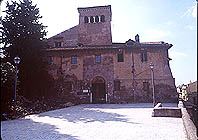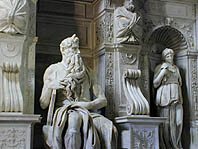Very Interesting Churches
Monastry of Ss. Quattro Coronati
 Down a little side street off Piazza San Giovanni in Laterano, you are suddenly back in the Middle Ages visiting this gem-like Medieval enclave.
Down a little side street off Piazza San Giovanni in Laterano, you are suddenly back in the Middle Ages visiting this gem-like Medieval enclave.
It is part of a convent, surrounded by giant fortifications that offered sanctuary to early popes from assaults by the powerful Roman nobles and other barbarians.
Today nobody knows anything about the four crowned martyrs for whom it was named, except they were killed for refusing to worship the pagan god of medicine, Aesculapius (see: Tiber Island).
The original church was twice as long and twice as wide, with the result that the rounded apse and the overhead women's gallery, reconstituted from the earlier building, look too large for this tiny basilica.
Note the lovely 12C Cosmatesque floor and an exquisite 15C Renaissance tabernacle in the last column on the left, to which Baroque frescoes were added in the 17C. There are usually a few nuns at prayer behind the forbidding bars that cut off the altar and its surrounding area. Be sure to ring the bell-pull on the left wall to visit the wonderfully mystical 12C cloister: like the contemporary cloister of St. Paul without the Walls, a truly spiritual garden.
The nuns are Augustinians, a closed order, so when you ring to enter the adjoining Chapel of St. Silvester (to the side of the first outer courtyard) the key will be passed to you through a rotating wooden hatch that prevents you from seeing the nuns inside their convent.
![]() The 13C cycle of frescoes in the Chapel of St. Silvester showing 8 purely legendary episodes concerning Pope Silvester I (314-335) and Constantine the Great (306-337).
The 13C cycle of frescoes in the Chapel of St. Silvester showing 8 purely legendary episodes concerning Pope Silvester I (314-335) and Constantine the Great (306-337).
Starting at the left on the wall above the entrance door and going around to the right, the somewhat stilted Byzantine-style cartoon series shows: “Constantine is stricken with leprosy; he dreams of Saints Peter and Paul; his three ambassadors ride out to summon the Pope”.
Around the corner on the side wall: “they climb Mt. Soratte to the papal monastery; back in Rome Silvester shows Constantine pictures of the two saints; Constantine is baptized by immersion (actually he was baptized on his deathbed); he is healed and offers Silvester his tiara and parasol; Silvester rides into Rome wearing the tiara, with Constantine at his feet”.
On the opposite side of the altar is “Silvester resurrecting a slain ox”.
Actually the Pope played no role in Constantine's conversion. But these frescoes are part of the Middle Ages' bloody struggle between Popes and Holy Roman Emperors - with the French kings heavy-handed intervention. The Church is here perpetrating a hoax based on the so-called “Donation of Constantine”, a notorious 8C forgery whereby the Emperor "granted" to the Pope not only spiritual but also temporal power over Rome and Italy.
|
Monastry of Ss. Quattro Coronati
History 4C. The original church was built, then enlarged over the centuries. 1084. Burned and pillaged by the Normans under Robert Guiscard, it was rebuilt by Pope Paschal II on a reduced scale, shorter and without side aisles. It served as a stronghold for the Popes when under attack while the Lateran Palace was their residence - just as Castel S. Angelo would serve when the Popes moved to the Vatican. |
Via dei Santi Quattro Coronati (Map L 8)
St. Pietro in Vincoli
(Basilica of St. Peter in Chains). Walk up to this church if you have time, climbing Via S. Francesco di Paola, also known as Salita dei Borgia, up a series of steps through a tunnel between Via Cavour and Piazza S. Pietro in Vincoli. This gives you the atmosphere of the place. The tower belonged to Pope Alexander VI Borgia; there he and his family mixed their deadly poisons. B.C. Believed to have been the site of a Republican era tribunal to which was later added a torture chamber for Christians. Discovered in the 1950's, was presumed to be where Emperor Nero's Court condemned St. Peter to death. 440 AD.Byzantine Empress Eudoxia, in Constantinople, received chains which had bound St. Peter, the first from Jerusalem and the other from Rome's Mamertine Jail. She sent one of the chains to her daughter, wife of Emperor Valentinian III of Rome, who built this church to house the precious relic. Later the other chain was sent to Rome, and the two chains magically fused together. 1475. Facade restored by Pope Sixtus IV della Rovere. 1492-1503. Next door, straddling the steep staircase with a balcony over it, is the so-called Borgia Palace, home of Vannozza Catanei, the mistress of Pope Alexander VI and mother of his two children: Cesare Borgia (who killed his half brother the Duke of Gandia) and Lucrezia Borgia, rumored to have been seduced by her father. 1505. Michelangelo was commissioned by Pope Julius II della Rovere to design his mausoleum.
The Duke of Gandia, legitimate child of the Pope's most famous mistress, Vannozza Cattanei, was killed in this building by his half-brother Cesare Borgia (the Pope's son) during a festive dinner their mother gave on 14 June 1497.

Michelangelo started out life as a sculptor who despised painting. This is the best place in Rome to see what he could get out of a block of stone.
Pope Julius II's Tomb. A bone of contention between Michelangelo and the Pope, who almost constantly quarreled about the design of what was meant to be the tomb to end all tombs. This gargantuan project, that Michelangelo called a "Tragedy of a sepulcher," was not finished in Julius' lifetime and subsequent Popes were too jealous to permit Michelangelo to return to it.
Forty statues were planned, of which several are dispersed around the world, but the Pope reposes in St. Peter's Basilica unloved. The three statues here that Michelangelo made for the tomb are arranged in a way that is not based on the overall plan for Julius' tomb.
Moses. This statue is arresting, with a virile Moses looking imploringly to God as he clutches the newly received commandments. The other statues for the tomb are Jacob's two wives: Rachel, symbolizing “Active Life”, and Leah, symbolizing “Contemplative Life”.
St. Peters’ two highly venerated chains, now joined, repose under the main altar.
History